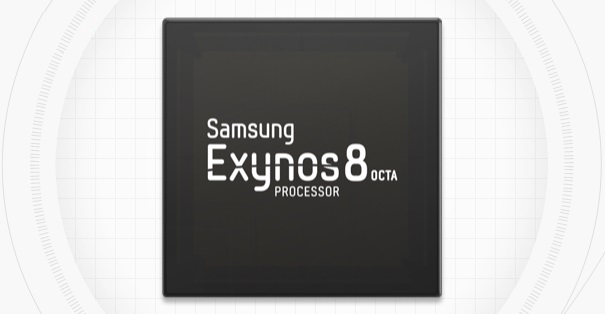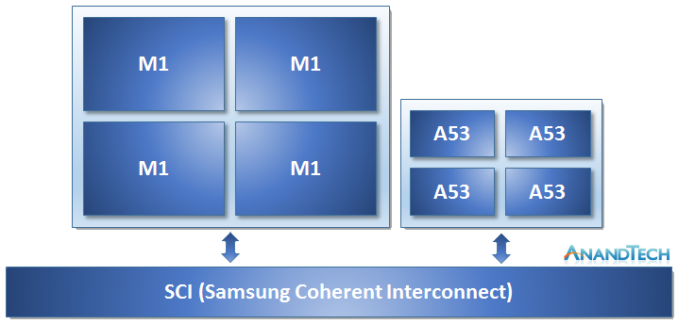Samsung Announces Exynos 8890 with Cat.12/13 Modem and Custom CPU
by Andrei Frumusanu on November 12, 2015 1:50 AM EST- Posted in
- Smartphones
- Samsung
- Mobile
- SoCs
- Exynos 8890
- Exynos M1

In an unexpected and surprise annoucement, Samsung today revealed its new generation flagship SoC - the Exynos 8. The Exynos 8890 to be more specific, is the successor to the Exynos 7420 that we've come to know very well in this year's Galaxy flagships such as the Galaxy S6 or the Note5.
The Exynos 8890 is still an 4+4 big.LITTLE design using four Cortex A53 cores in the little cluster, but on the big cluster we see for the first time Samsung's own custom developed CPU architecture deployed in silicon. The new core, officially called the Exynos M1, is the first fruit of years-long efforts by Samsung's Austin R&D Center to try to create an in-house CPU architecture. What we do know of the M1 is that it's still very similar to ARM's big core architectures (And thus might be a derivative) such as the A72: It's still a 3-wide OoO design with the same amount of execution pipelines and similar, although not quite identical pipeline stages on the execution units.
Samsung follows MediaTek's example by dropping the use of ARM's CCI IP in favour of designing their own cache-coherent interconnect fabric aptly named SCI (Samsung Coherent Interconnect). It seems that vendors are keen to try to improve their SoC architectures by designing fully optimized SoC fabric solutions and I guess Samsung saw the need to differentiate in this regard.
On the GPU side, we see usage of an ARM Mali T880MP12. This is the biggest Mali core implementation to date and increases the number of cores by 50% compared to the Exynos 7420's MP8 configuration. Keeping in mind that the T880 also increases ALU pipelines per core by 50%, we're looking at a 2.25x increase in computational power assuming Samsung kept the clock frequencies equal. Alternatively, they could go lower in frequency for much improved power efficiency. Samsung advertises 4K as an option for this SoC so likely we're looking at a very powerful GPU setup.
Lastly, but not least, is the announcement that the Exynos 8890 is part of Samsung's ModAP lineup, meaning this is a part with a modem. The new modem supports LTE Category 12 download speeds with up to 3x carrier aggregation up to 600Mbps or uploads speeds up to 150Mbps on Cat. 13 with CA. This effectively makes the new Shannon modem on the 8890 equal Qualcomm's Snapdragon 820 modem capabilities. Until further future confirmation on the matter, I fail to use the "integrated" word in regards to the modem due to Samsung's new product page presenting a graphic representing the modem/AP in a way that seems strikingly similar to a SiP (System-in-Package) solution, as opposed to an on-die solution.
The Exynos 8890 is announced to enter mass production in late 2015. With just six weeks left in the calendar year this likely means we're already seeing silicon being etched as we speak, just in time for Samsung's new Galaxy flagship early next year.
Source: Press release











56 Comments
View All Comments
alex3run - Friday, November 13, 2015 - link
Adreno was never a GPU to beat. And I doubt that the T880MP12 will struggle to compete with Adreno 530. The Apple's GPU, PowerVR GT7600, seems to be a stronger player at least in real games as synthetics lies very often.hung2900 - Friday, November 13, 2015 - link
"Adreno graphics they are using now is going to kill the standard mali designs used by Samsung"It's still unknown that the improvement of the new Adreno is purely architechture gain or they put more "cores" also.
"Maybe the mp12 mali helps them somewhat keep up but at what power cost"
More "shader cores" mean MORE power efficiency at the same workload. The real cost here is the bigger die size.
"People only think the exynos is so great because qualcomm faltered on 1 chip making a bad decision to scrap the next 32 bit design and release a standard 64 bit arm design just to jump on the 64 bit bandwagon" "Exynos has sucked and always will suck"
You're wrong. Many people including me still remember how crap the Crapdragon S3 was. So it's not only once for Qualcomm. The Exynos 4210 in S2 and Note 1 was simply lightyear ahead of Cradragon S3 that time.
jakeuten - Thursday, December 31, 2015 - link
Ahhh yes, the Exynos S2 on AT&T destroyed the S2 Skyrocket. I remember those days.poohbear - Thursday, November 12, 2015 - link
wow, so qualcomm is left out in the cold. Not boding well for qualcomm....geekbot - Saturday, November 14, 2015 - link
I am more curious to see what apple would be doing with the A10 chip next year. The increase in clock spead + improvment in process(20nm to 14 nm) helped them with their performance this year. As the 10nm tech will only be ready in 2017, not sure how much of improvement they can make. They still have a room to increase the clock speed from 1.8 ghz to something like 2.2 or add an additional core.jospoortvliet - Monday, November 16, 2015 - link
I am curious too as, by now, they have used all 'obvious' technologies to make their CPU cores perform great in single threaded workloads. Now they will have to innovate and break new ground...